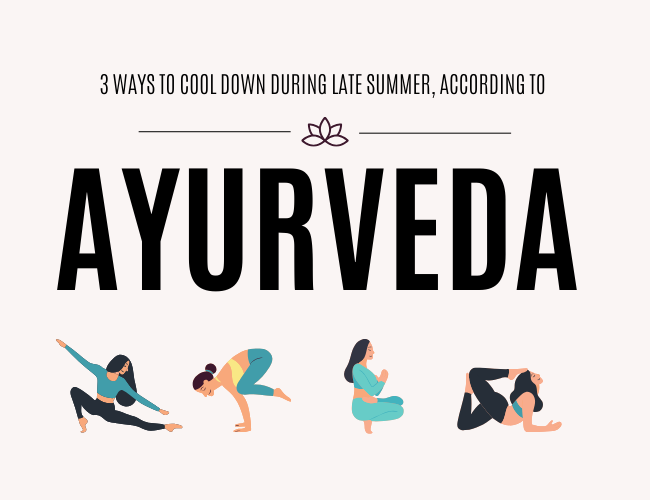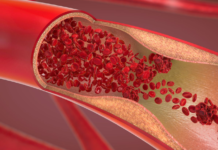Give your body what it needs.

According to the ancient science of Ayurveda, each of us is predisposed to experience the world through a unique lens. This is determined by the three primary energies within us, known as doshas: vata (air), pitta (fire), and kapha (earth). Just as there is a dosha that is dominant in our bodies and our personalities, there’s also a dosha that presides over each season. During the sweltering heat of summer, that dosha is pitta.
Some of us are born with mostly pitta in our constitution. The pitta person tends to run hot as they’re born with lots of fire in them. If you shake their hand, their skin is warm. They’re the type who will spend the summer with the AC cranked low and the ceiling fan on high while sleeping with one foot sticking out from under the sheets.
Even if you aren’t predominantly pitta, everyone’s got some of the dosha in their constitution. Pitta governs our digestion of everything—physical and emotional—and directs our transformation. Pitta helps us take in and assimilate nutrients, information, experiences, and relationships. It enables us to learn from our mistakes and move forward. And it can easily become aggravated when it’s hot and humid outside. That can create problems.
What are the Symptoms of Excessive Pitta?
An excess of pitta dominates your experience of life in a way that’s not subtle. Physically, excessive pitta tends to show up as feeling overheated and unusually uncomfortable when you’re outdoors. It can also manifest on your skin as redness, acne, rashes, or an allergic reaction. It can present in your digestive system as acid reflux, stomach upset, and diarrhea. It may even show up as burning or reddening in your eyes.
Excessive fire also tends to come out sideways in intense emotional reactions, commonly aggression, agitation, irritation, and frustration. However, simple lifestyle adaptations can bring things back into balance. Following are some of the most simple yet effecitve ways to balance the pitta dosha so you can feel more like yourself.
3 Ways to Cool Down During Late Summer
1. Temper Your Workout Regimen
Intense exercise to the point of exhaustion compounds the heat already present in pitta. Consider changing your outdoor workout routine to the early mornings or evenings when the temperatures are lower or turn down the temperature if you’re exercising or practicing yoga at home. If you typically practice nose breathing during your workouts, occasionally open your mouth during an exhalation to release heat. Exercising in a way that is intense and aggressive builds heat. You already know this. One solution is to shift your workout or practice to the early morning or evening when it’s cooler outside or to keep the inside temperature a little cooler than usual.
Also, consider adjusting the type of workout or yoga practice. Incorporate workouts that are more playful, such as Pickleball or swimming. If you practice yoga, instead of always taking fast-paced vinyasa class that culminates in arm balances and inversions, incorporate more slow practices that help you stay strong and flexible and boost circulation. Include more cooling stretches, such as wide-legged and wide-armed poses to release heat from the body. Also, practice more standing and seated forward bends, which are considered cooling in yoga tradition. You can also cool down with certain pranayama practices, such as Sitali and Nadi Shodhana or occasionally exhaling through your mouth to release excess heat.
2. Avoid An Excess of Heating Foods
According to Ayurveda, “heating” foods exacerbate and aggravate the heat already present in pitta. Whether something is “heating” has less to do with the temperature of what is eaten and more to do with the qualities it brings to the body. Heating foods include anything:
Oily
Spicy
Salty
Greasy
Acidic
Fried
Sour
Fermented
Other foods that tend to aggravate pitta include excessive amounts of coffee, alcohol, and red meat. Also, onions, garlic, and nightshades—including tomatoes, bell peppers, and potatoes—can be difficult for pitta to digest, especially when it’s hot and humid outside, and should be consumed only in moderation.
That’s a long list of what not to eat. Istead, focus on what can indulge in to balance pitta—that includes almost anything that’s abundant at local farmers’ markets. Think cool and watery fruits and veggies, such as watermelon and cucumbers. Also leafy greens, bitter and astringent sprouts, brussel sprouts, broccoli, and cauliflower, and pretty much any grain, including rice and quinoa.
You can also benefit from considering not just what you consume but the emotional state you’re in when you consume it. Put the phone down when you break to eat and take a few slow breaths beforehand. Focus on doing just the one thing, as rushed or distracted eating tends to lead to eating more quickly, which in turn leads to digesting less efficiently.
3. Relax Your Lifestyle
If your lifestyle is relentlessly intense—meaning you’re constantly on the go, juggling multiple responsibilities, and stressing out, that fuels the fire of pitta.
The solution is to slow down. Schedule some quiet time. Prioritize pleasure. And deemphasize sensory stimulation.
That will look differently for each of us. Perhaps you take a non-working lunch. Turn off the radio in the car. Leave your earbuds at home when you go for a walk or run. Swap out one run a week for a cooling activities such as swimming. Run through sprinklers. Simply spend some time in the shade.
But don’t become so intent on experiencing pleasure that you forget to rest. Reassure yourself that you don’t need to say “yes” to every social invitation and work obligation. Allow yourself to spend time however you want as long as it’s in a “non-productive” way. Let yourself stare at the dark indigo night when the air is cooler and consider it a meditative practice. Remind yourself of what John Lennon famously reminded us when he said, “The time you enjoy wasting, is not wasted time!”
Source: yogajournal.com

















